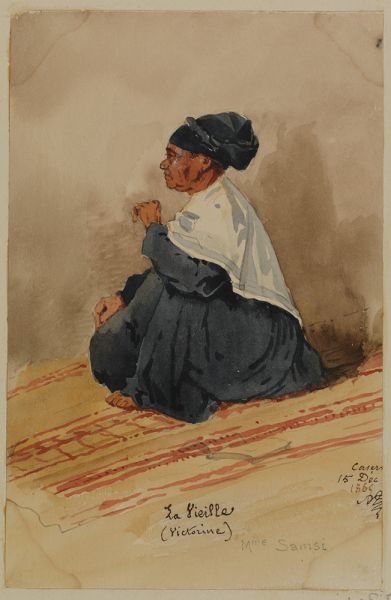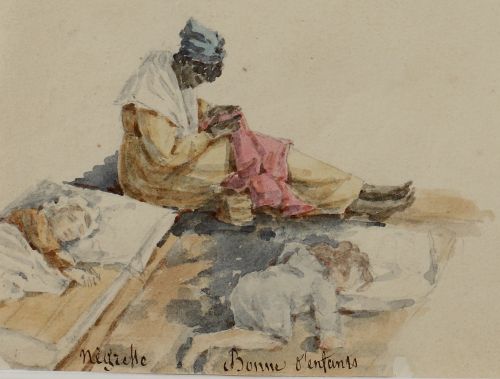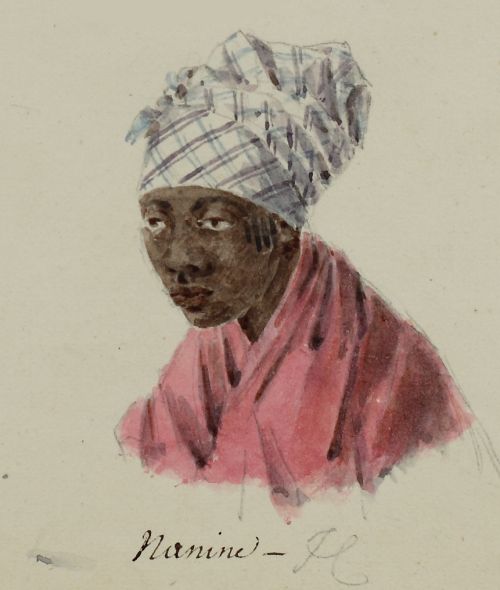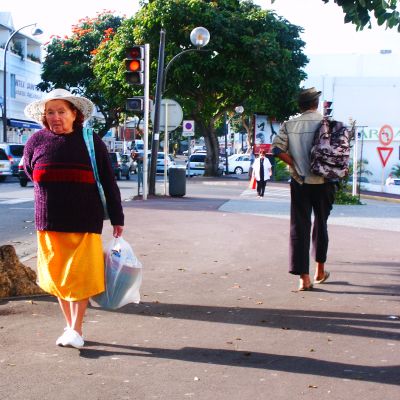Analysis of the Victorine's illustration
Watercolour by Hippolyte Charles Napoléon Mortier, the Duke of Trevise dating from 1865, and representing "the old lady", who was called Victorine

Context
Victorine was very old in 1866, 13 years after the French abolition of slavery.
Victorine may have arrived on the island as a child, as a slave. Young domestic slaves were in the permanent service of their masters, and apprenticed to older slaves.
When she reached an advanced age, Victorine must have played the role of trainer, or rather groomer, to her daughter, her granddaughters (born in the Habitation des Casernes in Saint-Pierre), and other young slaves/indentured servants in the Habitation.
Victorine was probably a former slave of Gabriel Le Coat de K/Véguen (1800-1860). The latter, a wealthy owner before the abolition of slavery, took the liberty of buying back their slaves from less well-off owners who were afraid of the prospect of abolition. So much so that at the time of the abolition in 1848, Gabriel owned more than a thousand slaves! He was by far the private owner who obtained the highest amount of compensation after abolition.
Victorine was the "nénène" (Creole word for "nanny") of Gabriel's daughter Emma, who married our watercolourist, Hippolyte Charles Napoléon Mortier.
In 1866, Victorine's boss was Denis-André Le Coat de K/Véguen, Gabriel's son, and Emma's brother. So Hippolyte's brother-in-law (you follow?)
Other examples of this outfit
In the course of our research, we found that this attire was widespread, and the captions often indicated that the people depicted had (among other things) childcare responsibilities.

Cafre women's portrait
This photographic portrait is later than the watercolour of Victorine: it dates from the years 1870-1890.
Despite this, it shows the same air of dignity, and also of great fatigue at the end of a long life of work and devotion to the masters, but above all, the same style of dress!
Photograph by Frédéric MAYDELL-LEGRAS (website in French)

Negress Nanny
The term "négresse" (negress) written just before the indication "bonne d'enfants" (nanny) was not pejorative in the 19th century. It simply indicates the colour of the skin and, in the case of Reunion, the ethnic origin: here, it was probably a slave taken from the east coast of Africa, in what is now Mozambique.
In Bourbon (the former name of Reunion Island), the term "cafre" is often used: some texts show that they were sought after by the owners because they were considered more docile.
Nowadays, this term has a positive emotional connotation.
Illustration of Jean-Baptiste Louis Dumas, 1927 (website in French)

Nanine
Nanine is probably a word used instead of "nénène", which means "nanny" in Creole. Her responsibility was immense: she had to watch over the welfare and protection of the children entrusted to her by their masters day and night. Moreover, in the event of an accident, it is she who receives the punishment.
Illustration of Jean-Baptiste louis DUMAS, 1827 (website in French)

The garden
The children of the nenes, or young servants, are at the service of the masters at all hours of the day and night.
Here, under the varangue (the terrace of the colonial houses to take advantage of the evening coolness), a little girl serves drinks to the master's family at dusk.
Illustration from Adolphe Martial POTEMONT, 1848 (website in French)
Credits - coutersy of : ©Iconothèque Historique de l'Océan Indien IHOI
The nénène's outfit
While it is true that the work of "nénènes" was common in different cultures, with the pictorial sources presented here we can clearly see a style of dress emerging:
Simply placed on the shoulders, it was made of wool or cotton, and the choice of colour was free (unlike the clothes, which were often dyed with indigo, the worker's marker of the sugar cane concessions)
"What was the use of this shawl on a tropical island, especially a woollen shawl?" you may ask...
Reunion Island is very mountainous, and when you "go up" or "down", the temperature changes according to the altitude, which varies very quickly, as shown in this diagram representing the agricultural staging. Note the use of the words "down" and "up", expressing height rather than distance. And look at the changing altitude... In a few kilometres as the crow flies, one goes from sea level to more than 3000 metres in altitude.
The Bel Air mine in Le Tampon, which inspired our project, was located at an altitude of 400 metres.
So you can understand that if the nénène moves with its masters, or to run errands for the house, it will necessarily have to change altitude, and it is better to cover up when the temperature changes so easily.
While the shawl is obvious, and presented as an important feature, it unfortunately hides the top of the dress.
From what we can see, it is a full dress, certainly to facilitate movement, and ankle-length.
As there were different styles at the time, it is difficult to decide which style was chosen for the upper body...
Very present in all the iconography we have gathered, the headscarf seems to be very common among women, whatever their work.
We will deal with this item in more detail later, as there is so much to say...!
Infography & photographies : Julien Vandanjon - AFAC974 / Objet Témoin ASBL
The Creole "nanny"
The term Nénène is also used in Mauritius and our esteemed colleagues at the Mauricianismes blog have published an edifying paper on the subject, which we warmly invite you to explore:
Further investigations
Representing this person is important to us. However, we lack the information to faithfully reproduce the garment under the shawl.
This can be seen as a freedom in the end: what is not visible can be whatever you want it to be, as long as the shawl sits on the shoulders and gives the same effect to the figure.
Other research is still being carried out, such as the style of clothing worn by servants at the time, in France for example.
If our readers have any suggestions, we would be delighted to hear them and share them with you! We invite you to contact us via the form on the Contact Us page

As can be seen in this photograph from the collections of the Maryland Historical Society from the article "Women in 19c century after civil war" Barbara Wells Sarudy has assembled many examples of representations of American "nénènes" from the same period, very similar to our "Victorine".








